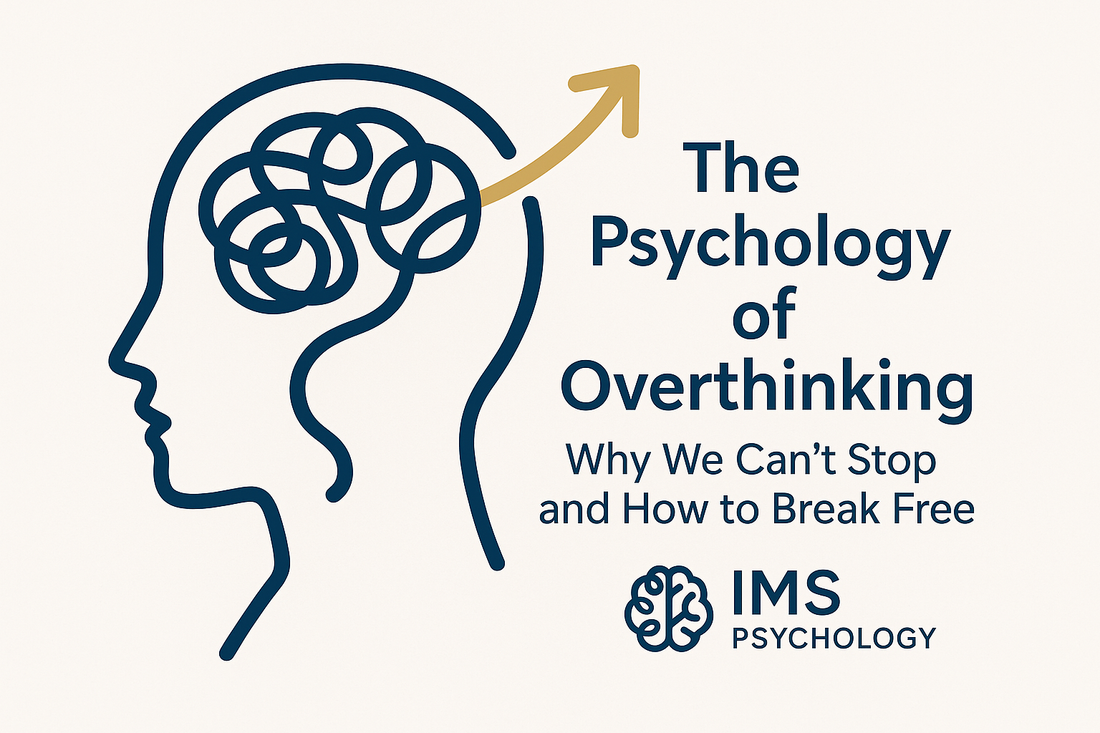
The Psychology of Overthinking: Why We Can’t Stop and How to Break Free
Share
The Psychology of Overthinking: Why We Can’t Stop and How to Break Free
Overthinking can drain your energy and amplify anxiety. Discover the psychology behind overthinking, why it happens, and practical ways to stop the cycle.
Introduction: The Endless Loop of Thoughts
We’ve all been there — lying awake at night, replaying a conversation or worrying about the future. Overthinking often feels like mental quicksand: the more you struggle, the deeper you sink. While reflecting on life is natural, when thought spirals become constant and intrusive, they can harm emotional health, decision-making, and even physical well-being.
Psychology offers powerful insights into why we overthink and, more importantly, how to break free from the cycle.
What Is Overthinking?
Overthinking refers to repetitive, unproductive thought patterns focused on the past, the future, or hypothetical scenarios. It is not the same as healthy problem-solving. Instead, it creates mental clutter without leading to constructive action.
Two main forms of overthinking are often identified:
-
Rumination: Replaying past mistakes, regrets, or painful experiences.
-
Worry: Imagining negative outcomes or potential threats in the future.
Both drain emotional energy and are closely linked to anxiety, depression, and stress.
The Psychology Behind Overthinking
Why do our minds latch onto certain thoughts and refuse to let go? Several psychological and neurological mechanisms play a role:
1. Evolutionary Roots
From an evolutionary perspective, scanning for danger helped our ancestors survive. Overthinking can be seen as a modern-day extension of this survival mechanism, but in today’s world, it often works against us.
2. Cognitive Distortions
Cognitive Behavioral Therapy (CBT) identifies cognitive distortions — mental filters that distort reality, such as catastrophizing (“everything will go wrong”) or mind reading (“they must think badly of me”). Overthinking feeds on these distortions, amplifying negative emotions.
3. Intolerance of Uncertainty
Acceptance and Commitment Therapy (ACT) highlights how humans struggle with uncertainty. Overthinking often emerges as an attempt to control the uncontrollable, even when no clear answers exist.
4. Neuroscience of Overthinking
Neuroimaging studies show that the brain’s default mode network (DMN) activates when we are at rest. This network is responsible for self-reflection and daydreaming, but in overthinkers, the DMN can become hyperactive, leading to excessive rumination.
Reference: American Psychological Association – Why We Worry
The Hidden Costs of Overthinking
While overthinking may feel like preparing for the worst, research shows it often leads to the opposite: paralysis and emotional exhaustion. Some common effects include:
-
Increased stress and anxiety
-
Sleep disruption and insomnia
-
Difficulty concentrating or making decisions
-
Heightened risk of depression
-
Reduced problem-solving ability
-
Physical symptoms such as muscle tension or headaches
Over time, this cycle can significantly impact well-being and relationships.
Why We Can’t Just “Turn It Off”
Telling someone to “just stop overthinking” is like telling a storm to stop mid-rain. Thought patterns are deeply ingrained and reinforced by both biology and experience. Breaking free requires more than willpower — it calls for evidence-based strategies that shift how we relate to our thoughts.
How to Break Free from Overthinking
The good news: psychology offers tools to quiet the mental noise and regain balance.
1. Cognitive Behavioral Techniques (CBT)
-
Thought Records: Write down intrusive thoughts, then challenge them with evidence.
-
Cognitive Reframing: Replace “What if everything goes wrong?” with “What if I can handle it?”
-
Behavioral Experiments: Test beliefs in real life to see if they hold true.
2. Mindfulness & Acceptance (ACT, DBT)
-
Observe, Don’t Engage: Notice thoughts like clouds passing rather than facts to act on.
-
Radical Acceptance (DBT): Allow uncertainty and imperfection instead of resisting them.
-
Grounding Techniques: Use the five senses to anchor in the present moment.
3. Limit “Worry Time”
Set aside 15 minutes daily as “worry time.” Research shows this containment strategy reduces intrusive thoughts throughout the day.
4. Shift from “What If” to “What Now”
Action disrupts overthinking. Small steps like making a call, tidying your space, or writing a to-do list can break paralysis.
5. Self-Compassion Practices
Self-criticism fuels rumination. Practicing self-compassion — recognizing your struggles without judgment — lowers stress and builds resilience.
6. Lifestyle Adjustments
-
Sleep Hygiene: Restorative sleep reduces overactive rumination.
-
Physical Movement: Exercise helps regulate the stress response.
-
Journaling: Externalizing thoughts creates distance and clarity.
When Overthinking Becomes Overwhelming
If overthinking interferes with daily functioning, it may signal underlying anxiety, depression, or trauma-related patterns. Seeking professional support from a therapist or counselor can help uncover root causes and teach tailored coping skills.
Practical Tools You Can Use Today
IMS Psychology offers downloadable, science-based workbooks that help you manage thought spirals with structured exercises and compassionate guidance. For example, our [Guide to Overthinking Workbook] provides step-by-step tools to break cycles of rumination and build mental clarity.
Conclusion: From Mental Loops to Mental Freedom
Overthinking is not a personal weakness — it is a learned pattern rooted in survival instincts, amplified by stress and uncertainty. The cycle can feel endless, but psychology provides a path forward. By applying practical strategies, cultivating awareness, and practicing self-compassion, you can quiet the noise and live with greater clarity and peace.
If you’d like to go deeper, explore our IMS Psychology workbooks, designed to turn insight into actionable change.
Explore our Overthinking Workbooks
written by,
Martin Rekowski (29.09.2025)